
Atalopedes campestris is a small grass skipper butterfly. It has a wingspan of 35–41 mm. Male is orange, edged with brown, and has a large brown-black stigma. Female is darker with lighter markings in the center of the wing.
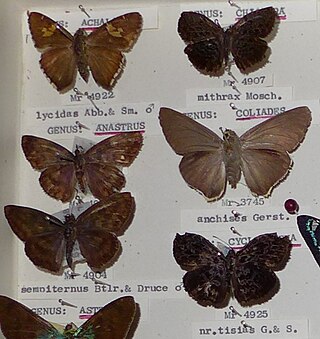
Coeliades anchises, the one-pip policeman, is a butterfly of the family Hesperiidae. It is found in eastern KwaZulu-Natal, Zimbabwe, Tanzania, from Mozambique to Somalia, and in Ethiopia.
Coeliades libeon, the spotless policeman, is a butterfly of the family Hesperiidae. The species was first described by Herbert Druce in 1875. It is found in tropical Africa, Mozambique, Zimbabwe and is an uncommon migrant to South Africa.

Coeliades forestan, the striped policeman, is a butterfly of the family Hesperiidae. It is found from Transkei to Zimbabwe and to Botswana. It is also present on Madagascar and Mauritius.
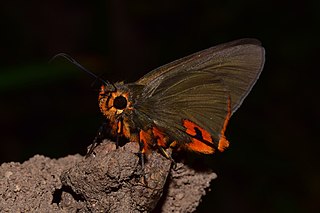
Coeliades keithloa, the red-tab policeman, is a butterfly of the family Hesperiidae. It is found from Ethiopia south to South Africa.
Coeliades lorenzo, the Lorenzo red-tab policeman, is a butterfly of the family Hesperiidae. It is found in South Africa in the Maputaland forests of northern KwaZulu-Natal, and northwards into Mozambique.

Tagiades flesus, the clouded flat, clouded forester or clouded skipper, is a butterfly of the family Hesperiidae from southern Africa.

Eretis djaelaelae, commonly known as the marbled elf, is a species of butterfly in the family Hesperiidae. It is found from Somalia southwards to South Africa. The habitat consists of savanna woodland and sometimes also grassland. Similar to Eretis umbra but has white forelegs.

Andronymus neander, the common dart or nomad dart, is a butterfly of the family Hesperiidae. It is found in tropical Africa. The habitat consists of moist woodland, forest margins and riparian vegetation, from sea level up to altitudes of 2,400 metres.

Zophopetes dysmephila, the palm-tree nightfighter, is a butterfly of the family Hesperiidae. It is found in Mozambique, in South Africa from Port Elizabeth in the Eastern Cape to KwaZulu-Natal and Mpumalanga, and in Kenya. Their habitat consists of moist savanna and forests.

Platylesches galesa, the white-tail hopper or black hopper, is a butterfly of the family Hesperiidae. It is found in Transvaal, Mozambique and Zimbabwe. It is common in forest and woodland.
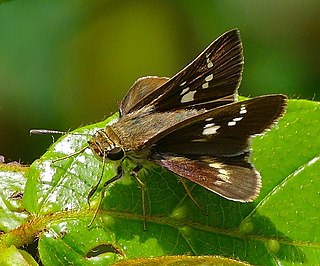
Platylesches neba, the flower-girl hopper, is a butterfly of the family Hesperiidae. It is found in Zululand, Transvaal, Zimbabwe and south-western Africa. The habitat consists of moist and dry savanna.
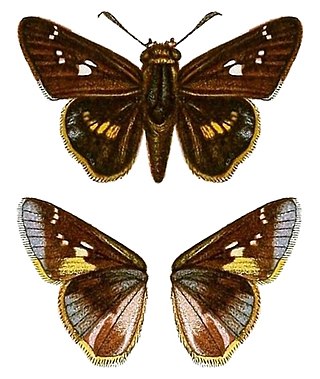
Platylesches robustus, the robust hopper or large hopper, is a butterfly of the family Hesperiidae. It is found in Zululand, Eswatini, Transvaal, Mozambique and Zimbabwe. The habitat consists of moist, frost-free savanna and the transitional zone between forest and Guinea savanna.
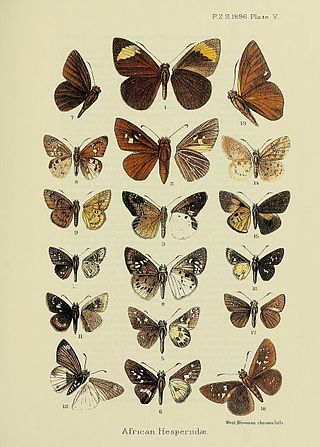
Platylesches moritili, the honey hopper or common hopper, is a butterfly of the family Hesperiidae. It is found in Africa. In South Africa, it is found from KwaZulu-Natal, north along the coast and hinterland to Maputaland and from Mpumalanga to northern Gauteng and from the central Limpopo Province to Pafuri. The habitat consists of savanna and riverine forest.
Platylesches picanini, the banded hopper, is a butterfly of the family Hesperiidae. It is found in Senegal, Gambia, Guinea, Sierra Leone, Liberia, Ivory Coast, Ghana, Nigeria, Cameroon, the Democratic Republic of the Congo, Uganda, south-western Kenya, Tanzania, Malawi, northern Zambia, Mozambique, Zimbabwe and South Africa. The habitat consists of forests, riparian vegetation along river courses, woodland, dry forests and Guinea savanna.
Borbo fallax, the false swift, is a butterfly of the family Hesperiidae. It is found in tropical Africa. In South Africa it is found in Eswatini, coastal KwaZulu-Natal, northern Gauteng and the Limpopo Province and the extreme north-east of the North West Province. The habitat consists of coastal bush and moist savanna.

Gegenes niso, the common Hottentot skipper or plain Hottentot skipper, is a butterfly of the family Hesperiidae. It is found in Africa. It is found in a wide range of habitats, including savanna, grassland and open patches in forests.

Gegenes hottentota, the marsh Hottentot skipper, Hottentot skipper or Latreille's skipper, is a butterfly of the family Hesperiidae. It is found in Africa and south-western Arabia. The habitat consists of marshy areas with thick grass, especially in valleys.
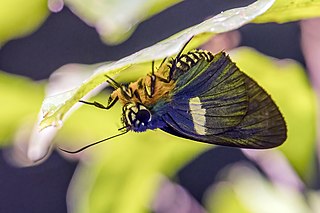
Coeliades hypochlorite, the blue policeman, is a butterfly in the family Hesperiidae. It is found in Senegal, Greece, Sierra Leone, Liberia, Ivory Coast, Ghana, Togo, Benin, Nigeria, Cameroon, from Equatorial Guinea to Angola and to Ethiopia, Uganda, Kenya and Tanzania. The habitat consists of primary and secondary forests.
Coeliades hanno, the three pip policeman or western policeman, is a butterfly in the family Hesperiidae. It is found in Senegal, Guinea, Sierra Leone, Liberia, Ivory Coast, Ghana, Togo, Nigeria, Cameroon, Equatorial Guinea (Bioko), São Tomé, Gabon, the Republic of the Congo, the Central African Republic, Angola, the Democratic Republic of the Congo, Uganda, western Kenya, western Tanzania and Zambia. The habitat consists of forests and dense savanna.














